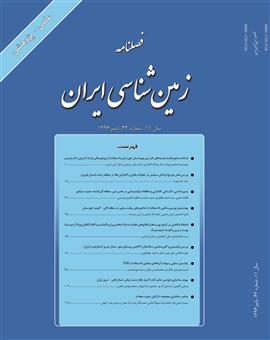زمین¬شناسی، دگرساني، كانه¬زايي و مطالعات ژئوشیمیایی در معدن مس، منطقه گل¬چشمه، جنوب نیشابور
محورهای موضوعی :فاطمه نجمی 1 , سید احمد مظاهری 2 , سعید سعادت 3 , اعظم انتظاری هرسینی 4
1 - دانشگاه فردوسی مشهد
2 -
3 - دانشگاه پیام نور تهران شمال
4 - دانشگاه پیام نور
کلید واژه: گل¬, چشمه آندزیت کانه¬, زایی دگرسانی مس مانتو میشیگان,
چکیده مقاله :
معدن مس گل چشمه در شمال شرق ایران (جنوب شهر نیشابور) در حاشیه زون ساختاری سبزوار واقع گردیده است. براساس مطالعات صحرایی و آزمایشگاهی، رخنمون های سنگی این منطقه شامل سنگ های آتشفشانی منسوب به ائوسن و یا جوانتر با ترکیب آندزیت تا بازالت به همراه واحدهای رسوبی، سنگ-آهک و میان لایه هایی از توف و برش می باشد. زون های دگرسانی مرتبط با لایه های آندزیتی - بازالتی شامل کربناتی شدن، پروپلیتیکی، اندکی سیلیسی، آرژیلیکی و سرسیتی می باشد و کربناتی شدن مهمترین دگرسانی منطقه می باشد. کانه زایی بهطور گسترده درمیان واحدهای آتشفشانی منسوب به ائوسن و یا جوانتر رخ داده و از نظر بافتی بهصورت رگه ـ رگچه، پرکننده حفرات و فضاهای خالی (آمیگدالوئید)، دانه پراکنده، آغشتگی در پلاژیوکلازها و جانشینی صورت گرفته است. بر پایه مطالعات کانه نگاری صورت گرفته، کانه های اصلی حاوی مس به دو فاز اکسیدی و سولفیدی قابل تفکیک هستند که کانه زایی بهطور عمده شامل فاز اکسیدی است و بهصورت آغشتگی در سطوح شکستگی ها و خلل و فرج و یا پرکننده فضاهای خالی در سنگ میزبان مشاهده می شود. کانه های اکسیدی بهصورت کانه های کربناتی و سیلیکاتی مس شامل مالاکیت، آزوریت و کریزوکلا بوده و کانههای سولفیدی مس شامل کالکوسیت، کوولیت، به مقدار جزئی کالکوپیریت، بورنیت، دیژنیت، تتراهدریت و همچنین مس خالص بوده که در این بین، کالکوسیت ها بیشترین فراوانی کانه های سولفیدی را دارا می باشند. کانه اصلی سولفیدی مس در این محدوده کالکوسیت می باشد که احتمالاً شاهد دو نسل از آن هستیم. نسل اول که بهصورت اولیه و پراکنده در اکثر نقاط تشکیل شده است و نسل دوم کالکوسیت که از تبدیل بورنیت و کالکوپیریت بهصورت جانشینی و در شرایط سوپرژن ایجاد شده است. مطالعات ژئوشیمیایی حاصل از این پژوهش نشاندهنده این است که سنگ های آتشفشانی موجود در منطقه ماهیت بازالت های کالک آلکالن با گرایش شوشونیتی را داشته و از نظر جایگاه زمین ساختی احتمالاً شاخص ماگماتیسم کمان قاره ای مرتبط با زون فرورانش می باشد. علاوه بر این، بر پایه نتایج حاصل از آنالیز عناصر کمیاب و نادر خاکی مقدار بالای Nb (بیش از 16 گرم در تن)، غنی شدگی Rb و نسبت (Zr/Nb)N ( کمتر از 2 و بین 7/0 تا 46/0) می تواند نشان دهنده ی آغشتگی ماگما با پوسته قاره ای باشد. عدم وجود آنومالی مشخص از عنصر Eu نشاندهنده شرایط ذوب در حالت اکسیدان می باشد. با توجه به مطالعات صورت گرفته و با تأکید بر شواهد مختلف از قبیل محیط زمین ساختی، کانی شناسی و نوع سنگ دربرگیرنده، ساخت و بافت ماده معدنی، پاراژنز کانهنگاری، شکل ماده معدنی و عناصر همراه، این منطقه معدنی با ذخایر مس نوع مانتو واقع در شیلی مقایسه گردیده است و علیرغم پاره ای از تفاوت ها، می توان منطقه گلچشمه را در رده کانسارهای تیپ مس نوع مانتو طبقهبندی کرد.
The Golcheshmeh copper deposit is located in the NE of Iran (south of Neyshabour) at the margin of Sabzevar Structural Zone. Based on geological and labratory studies, the outcroped rocks consist of Eocene volcanic rocks such as andesite, basaltic- andesite and basalt that associated with the sedimentary and volcanosedimentry rocks including limestone, tuff and breccia. The alteration hosted andesitic layers include carbonatization, propylitization and less argilic and sericitic alterations. The carbonatization zone is the most important alteration in this area. Mineralization mainly occurs in Eocene or younger volcanic rocks as vein- veinlets, amygdaloidal fillings and some replacement and disseminated styles. According to the minerallographical studies, the main ores which contain copper are divided into oxide and sulfide types. Mineralization mainly consists of oxide phases and can be seen as contamination of fracture surfaces and filling pores or voids in the host rocks. The main oxide minerals are malachite, azurite and chrysocolla, and sulfide minerals are chalcocite, covellite, with some minor pyrite, chalcopyrite, bornite, digenit and also native copper. Chalcocite is the most abundant ore sulfide in this area. There are probably two generations of sulfides, the first generation is a primary ore that was formed directly in joints, cracks, and fractures from the ore-containing solution and currently is replaced by covellites; and, the second generation is chalcocite that was probably formed from the conversion of bornite and chalcopyrite through substitution under supergene conditions. In most cases, the observed intergrowth between copper ores suggests the multi-stage mineralization in this region. Geochemical studies of minor and trace elements indicate that the igneous rocks in this region are characterized by the calc-alkaline basalt characteristics and, in terms of tectonic setting, could be attributed to subduction zone-related continental arc magmatism. Moreover, based on the performed geochemical analyses, the copper grade in the region varies from 13668 to 164000 g/ton. On the basis of the results of this study and with respect to some evidences such as tectonic setting, host rock type, structure and texture of ore body, mineral paragenesis, shape of the ore body and associated elements, this area is compared to Manto type deposit located in Chile. Though there are some differences, it is suggested that golcheshmeh copper mine is classified in Cu- Manto type deposit.


